When we were in Lancaster for vacation, I bought too much fruit. Every time we stopped by a roadside farmstand, I’d enter a fugue state in which I’d forget how much food we already had at our cabin and would buy more (it was all so cheap! and gorgeous! and fresh!).
By the time we headed home last Sunday, I had a gallon-size ziptop bag full of peaches and plums that were rapidly ripening. The bumps they received in transit didn’t help preserve their quality and by the time they were back in the kitchen, they were in dire shape. At one point, my husband suggested just throwing them away.
Not wanting to waste the fruit that I’d spent my vacation cooing over, I decided to make a quick batch of skillet jam. Simmered in a large, stainless pan, this jam cooks up in less than ten minutes, making it the perfect way to preserve overripe fruit quickly and without a ton of fuss. Because I never know when to quit, I always do these things in the moments before bedtime. A fresh jar of jam come morning is never a bad thing.
After cutting away the bruises and moldy spots from my peaches and plums, I had 2 1/2 cups of chopped fruit. Combined with 1/2 cup honey and six lemon verbena leaves, I cooked it all together over high heat, stirring regularly until the juices thickened. The lemon verbena leaves added a nice citrus-y flavor. They don’t do anything to increase the amount of acid in the jam though, so if the jam is struggling to set up, squeeze half a lemon’s worth of juice into the pan as well.
You know a skillet jam is done when you can pull the spatula through it and jam doesn’t immediately rush in to fill the empty space. Another way to tell the cooking is finished is that it develops and holds those tiny little bubbles around the edges in the photo below. When you stir it, the jam should burble and simmer feverishly. Jam always tells you when it’s done if you look and listen closely.
Because it only uses honey as a sweetener, this jam tastes more of fruit than sugar which is a good thing in my book. The only downside of jamming with honey is that it doesn’t have the same preservative powers as sugar, so it won’t last for eons in the fridge. It could be safely canned for longer storage, but just I did it, it’s got about two weeks before it will start to develop mold. However, at the rate I’m eating it, spoilage won’t be an issue.
Making a skillet jam like this isn’t just limited to peaches and plums. You can do this same sort of technique with berries, pears, nectarines, apricots and more. One could also portion this jam out into two containers and pop half in the freezer, should you be the type who struggles to finish a jar.
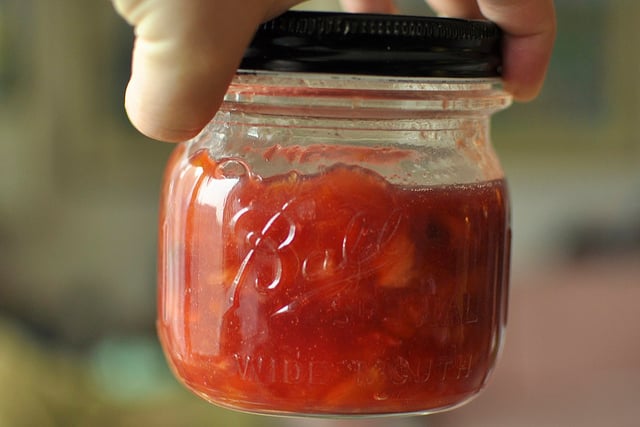
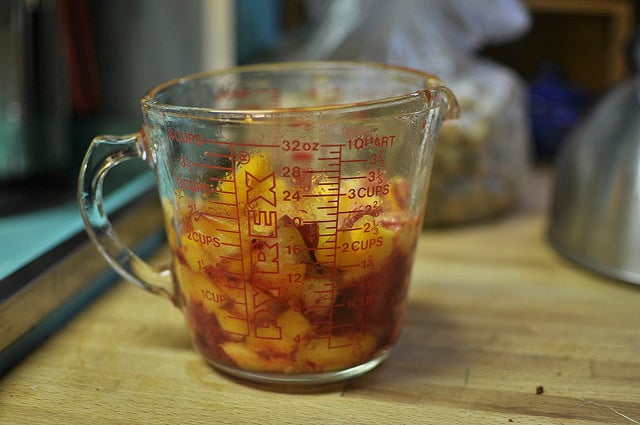
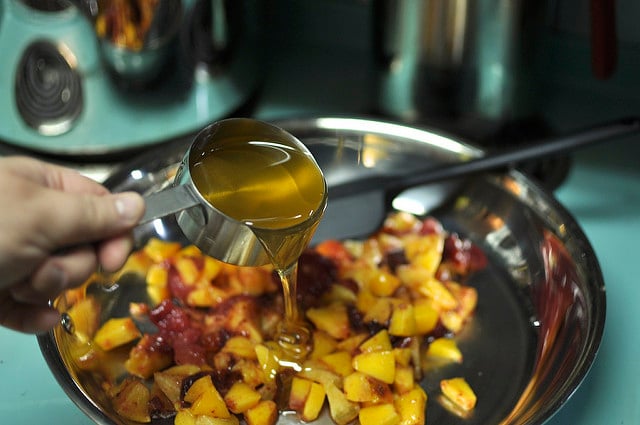
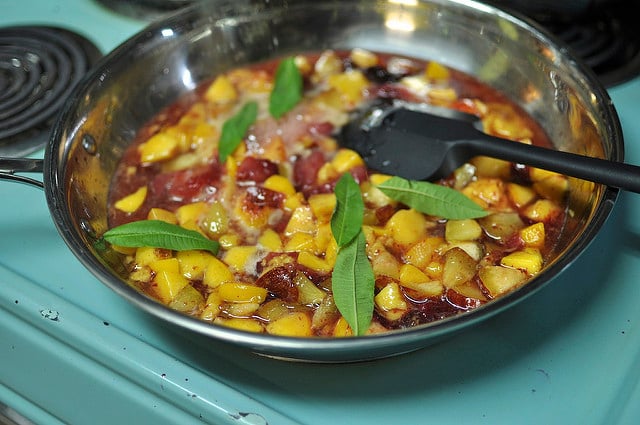

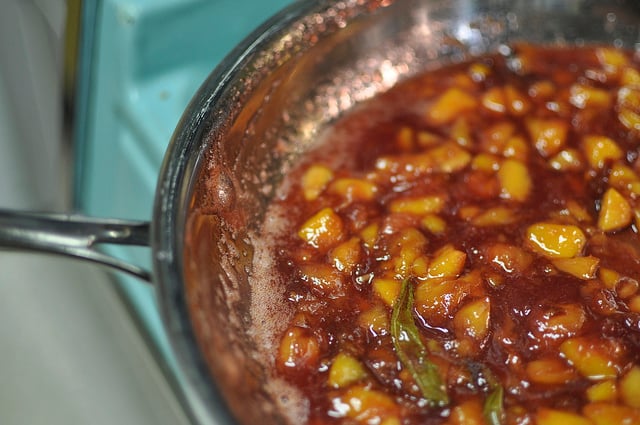

I thought one wasn’t supposed to cook honey. I read it somewhere that it becomes toxic at certain temperatures and then I thought honey was one food that never went bad, in its natural state or something like that. Have I been mythed by some website that don’t have their facts straight?
Well, it sounds yummy and if u didn’t get sick from cooking it, then I’m in.
That is a myth that honey becomes toxic when cooked.
Whipped up a quick batch of this jam last night with a couple of adjustments: 3C fruit, 1/4C each of honey & roasted sugar, mint leaves (since that’s what we’re growing). It was heavy on the nectarines – both white & yellow – with just one tiny plum in the mix, and a couple of sad peaches. Yield was just under one pint, and it made this morning’s breakfast delightful! Thanks for the constant inspiration to use what I have and transform it into something delicious.
I’m so glad that you were able to make the recipe work for you!
A couple of years ago we planted a nectarine tree and this year we have a huge crop. In search of a way to preserve my bumper crop I ran across your website and this recipe. I am eager to try this recipe but I do not have fresh lemon verbena. I know, it’s already on my list to add to my herb garden. Anyway, in the meantime is it a necessary ingredient or can I leave it out? Also, being new to canning and not well versed in the art I was wondering if I water- boil/bath the jars how long is the jam shelf-stable? Thanks!
You can totally leave the lemon verbena out. Consider adding a little lemon zest for a similar flavor. And you can process this jam for ten minutes in a boiling water bath to make it shelf stable.
I whipped up a batch of peach and pear skillet jam last night. I put it up in sterilized jars (without the water bath), as I’ve done with jam, chili sauce, and pickles in the past. Since then I’ve read about skillet jams being kept in the fridge or frozen. I tested the seals this morning and they look good. My question: will this keep without being refrigerated or frozen? I used 5 cups of fruit (peach and pear, in equal-ish amounts), one cup of honey, and the juice of one lemon (also some grated nutmeg and lemon rind). I’d be happy for some advice. Many thanks, and I am thrilled to have stumbled across this site.
Julia, it’s never a good idea to skip the boiling water bath process. All homemade preserves should be processed in a boiling water bath, including your jam, chili sauce, and pickles. It’s not that this jam is in any more risk of going bad than those other foods, it’s just an important part of the preserving process.
Hi! Just wanted to say thanks for this recipe! I tried it last night with a ton of overripe plums, pluots and nectarines and it was easy to make and so ridiculously good! I modified it slightly, using 8 cups of cut fruit, 3/4 cup of agave syrup (instead of the honey), and the juice of 1 lemon, plus about a dozen lemon verbena leaves. It made a 16 oz. jar for our house and two 6 oz. jars to share. Looks really pretty, and tastes like Summer at its best! Thanks again! 🙂
Thanks for this recipie! I whipped up a batch this morning with a few peaches from our farm trip that were going soft too quickly and we spread it over our French toast for brunch. Delicious. I will have to make more. Longevity was not a problem for us either.
Hi,
Just stumbled on your website and LOVE it. 🙂 And I already have a few recipes marked for trying out. 🙂 Can this specific recipe work with strawberries? Or would I need to add a bit of lemon? I just want to use less refined sugar, no pectin, and keep the fruit as fresh-tasting as possible. I imagine I’d need to boil in a water bath if I want to keep it shelf-stable, right?
Thanks!
Hello!
Just made a double patch of this omitting the lemon verbena and adding 2 vanilla beans. Simply lovely result. Very pretty with all the vanilla seed flecks throughout.
Thank you for sharing.
Thanks so much. I have been reading your blog and loving it!
Glad to know somebody else loses control at farm stands! I hate taking the 101 to Santa Barbara, so I take the 118, which turns into a farm road to Oxnard. In Somis, there are a couple of great farmstands, including one with pick-your-own blueberries/raspberries possibilities. I go into some sort of fugue state there and come to only when I arrive home wondering why I have enough produce to feed the entire block…
Thanks for this post. I just used a couple of white peaches (that were never going to ripen) and a tiny bit of grated nutmeg to make skillet jam. I could have eaten that with a spoon–forget the toast or muffin! It got better after a couple of days in the fridge.
I was completely inspired to step away from my laptop and cook some up. Posted pics to my FB, but I can’t post them here. I tried. Oh, and I added a piece of peeled ginger to the mix. OMG, the smell was phenomenal.
I recently discovered that small batches are really special. A couple weeks ago, one of my colleagues (who knows I am *mad* about canning & preserving) whispered in my ear: “The peaches on the tree in the back yard (of our office) are ripe.” I picked the ripe ones, they were small but sooo sweet!!! I brought them home and made peach butter–my yield was 2 pints. OMG, it is sooo good!!! I shared the love by taking it to a weekly breakfast get-together with friends. Thanks for a great blog–really looking forward to your book. : )
I think I might try this with the plums I have tomorrow – thank you so much 🙂 🙂
I just whipped up a batch of this. I had made conventional peach jam today and had leftover peaches and wasn’t sure what to do with them. I just chopped up about 3 1/2 cups of peaches and combined them with 1 cup of honey, a scant 1/4 cup of lemon juice, 1/8 teaspoon cinnamon and a teeny pinch of ground cloves. Put all of that in my big skillet and followed your lead. All I can say is YUM! I wound up with two 1/2 pint freezer jars and one 4 oz canning jar of the most delicious jam. It isn’t too sweet and I can taste the honey and lemon. I like it better than the big batch of peach jam I made this morning! Thanks from a newbie canner; couldn’t have been easier!
That looks gorgeous. I just want it hot, out of the pan and poured straight over frozen yogurt or ice cream.
I really enjoyed this post as well. I’ve been meaning to buy canning equipment and learn how to can for the past two summers, but time and to a certain extent money has prevented me from doing so. This looks like something I could easily try without having to buy all the canning equipment. Thanks!
What size jar is that in the picture? I imagine that it’s a vintage one but I love it and would love to find some.
It’s an old, squatty pint jar.
Could you do mangos like this?
I know you normally do local fruit, but I love mangos so much, I have 3 nice ones (about 2 lbs) they are so sweet that I hesitate to put in as much sugar as all the jam recipes say you need.
Lily, Mangoes are not acidic enough to can on their own. I would not recommend doing this method with mangoes.
I made this skillet jam today, but instead of lemon verbena, I added a couple of cinnamon sticks and the scrapings from a vanilla bean. Very yummy!
What if I added a little alcohol to this, say Lillet or another fortified wine? Could I still use the water bath method? Life has kept me busy and I have a number of quickly ripening peaches. Thanks so much!
Megan, I imagine it should be fine. Alcohol is a preservative, after all.
I just bought some honey from the farmer’s market and this jam looks so easy and delicious, I might have to make it (probably, like you, when I should be going to bed)! 🙂
I’m surprised that honey doesn’t have the same preservative effects as sugar. Honey is extremely shelf stable, and literally no bacteria can live in it because there is very little water in it. I am going to try this with the over-ripe peaches and nectarines I have. Great idea for fruit past it’s prime!
What you say about honey is true in its regular state. The problem is that once you boil honey into something, it looses much of its preservative power.
Good to know! Making this right now. Can’t wait to eat it!
Honey can contain spores of Clostridium botulinum, which can cause botulism and is the reason you shouldn’t give honey to infants.
I love this! So quick and easy. And less sugar more fruit flavor is definitely ok in my book as well.
I’ve just started reading your blog a few weeks ago and am obsessed! I’ve made a couple batches of jam and I love the idea of using honey instead.
Also, do you have a good recommendation on where to buy cheap canning jars? Or if I have antique jars can I use them if I sterilze them in boiling water and buy new lids?
Love your blog!! 🙂
Kathryn, there’s not a lot of variety in canning jar prices if you’re buying them new. On occasion you can find coupons that will bring the cost down $.50-$1, but that’s probably the best you can expect to find. You can use those vintage jars, here’s a post I wrote a while back about things to look out for when canning in used jars: https://foodinjars.com.s164546.gridserver.com/arugulapesto/2009/04/buying-used-jars/
Thanks for the info, Marisa!
Love this idea – so quick and easy!
Beautiful pictures, Marisa. I don’t have lemon verbena leaves. Can I use rosemary and just squeeze in lemon?
Sure!
Looks luscious, Marisa! Once my power comes on from the outage the storm caused, I might make some!!!
That sounds great, and I love that it’s just some honey instead of cups upon cups of sugar. Could one pressure can this jam?
No need to pressure can jam like this, peaches and plums are plenty acidic. For longer storage, you could boiling water bath can it.
Would you process this in a boil water bath for 10 minutes to be shelf storable?
Yes, you could boiling water bath can it for 10 minutes.
Marisa- that looks so delicious. Great photos, too! I made peach preserves with honey and St. Germain last night…so good 😉
Hi, I’m a pretty new reader. Could you make a tomato jam this way? I made some using your recipe (and it worked wonderfully) but was wondering if it could be made in a smaller batch (cooking down the 5 lbs took a long time, over 2 hrs) Thanks!
I’ve never tried it, but I imagine you could. You’d have to stir very regularly though, because that tomato jam can sometimes stick.
This is a great recepie!! I used a fresh sprig of rosemary from our garden and a splash of concentrated lemon juice. I can’t stop eating it while spooning it into the jar, lol.